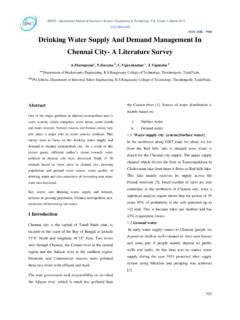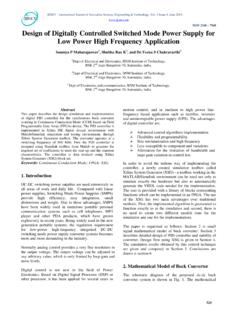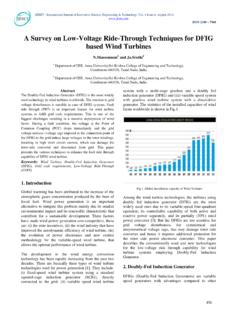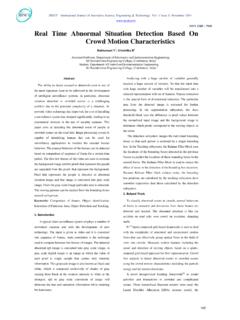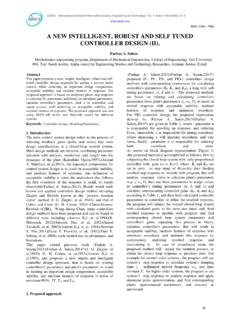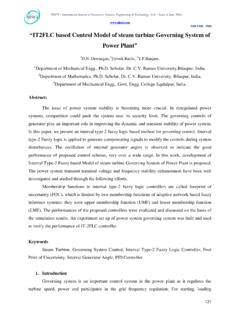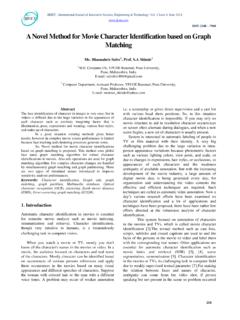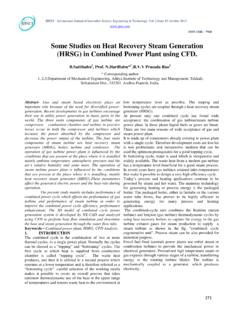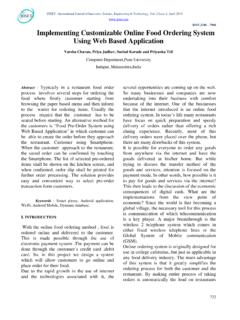Transcription of Power Optimization Using EPAR Protocol In …
1 IJISET - International Journal of Innovative Science, Engineering & Technology, Vol. 1 Issue 6, August 2014. ISSN 2348 7968 Power Optimization Using EPAR Protocol In MANET Haseena 1, Sheena Anees2 and Neela Madheswari3 1 Department of Computer Science and engineering, 2 Departmen of Information Technology, 3 Department of Computer Science and engineering, KMEA Eng college, Aluva, Kerala Abstract Now adays lot of important tasks are performed Using MANET. To improve the communication energy efficiency at individual nodes Power aware is an important issue.
2 Here we propose an efficient Power Aware Routing (EPAR), a new Power aware routing Protocol that increases the MANET lifetime . Comparing to conventional Power aware algorithms, EPAR identifies the node capacity not just by its battery Power , but also by the energy lost in reliably forwarding data packets over a specific link. This is by a mini-max formulation, EPAR selects the path that has maximum packet capacity at the lowest residual packet transmission capacity. In addition to EPAR we consider the traffic density factor to improve the packet delivery ratio.
3 Thus to find the optimal path we are considering the node with maximum Power and maximum number of neighbouring nodes to it. our proposed scheme thus reduces the total energy consumption and decreases the mean delay especially for high load networks while achieving a good packet delivery ratio. Keywords: EPAR, AODV, DSR. 1. Introduction Wireless network has become increasingly popular during the past decades. There are two variations of wireless networks- infrastructured and infrastructureless networks. In infrastructured networks communications among terminals are established and maintained through centric controllers.
4 Infrastructureless network is commonly referred to as wireless adhoc network. Such a network is organized in an adhoc manner, where terminals are capable of establishing connections by themselves and communicate with each other in a multi-hop manner. MANET is group of mobile nodes that form a network independently of any centralized administration .each moving nodes act as a host and router and forward packets for other nodes. The moving nodes in this network continously changes its network topology and allows biedirectional and unidirectional link.
5 MANET have many applications ,they are applied in Military Scenarios ,Rescue Operations , Data Networks ,Free Internet Connection Sharing , Sensor Network etc __All mobile nodes are battery operated. They are suffering from limited energy level problems and the battery lifetime extention is very important aim. Some nodes get down due to Power exaustion and thus often reduces the lifetime of manet. Nowadays researchers are trying to develop efficient energy routing protocols. Although there are other types of protocols like DSR ,DSDV, AODV etc these protocols makes routing based on the smallest distance routing algorithm and never consider the factor Power .
6 But in an energy efficient routing Protocol the main considering factor is Power . 2. Motivation There are lot of related works regarding Power Optimization in manet. In [1] we use a new Power aware routing Protocol called (EPAR) which can increase the MANET lifetime. In [2] they are discussing about Power consumption aspect of the MANET routing protocols. A performance comparison of Dynamic Source Routing (DSR) and Ad hoc On-Demand Distance Vector (AODV) routingprotocols with respect to average energy consumption and routing energy consumption are explained.
7 In [3] they considers energy constrained routing protocols and workload balancing techniques for improving MANET routing protocols and energy efficiency and also give new routing Protocol that employs adaptive load balancing technique to 430 IJISET - International Journal of Innovative Science, Engineering & Technology, Vol. 1 Issue 6, August 2014. ISSN 2348 7968 the MANET routing protocols with node caching enhancement. Also, we show new application of energy efficiency metrics to MANET routing protocols for energy efficiency evaluation of the protocols with limited Power supply.
8 In[4] they first introduce anenergy consumption model to calculate the energy-factor1 of the nodes and then propose a trust based Protocol forenergy-efficient routing. Here they also adopt a trust module to track the value of routing metric. In [5] they presents E2 DYMO, an improvement to the well-known DYMO Protocol that offers energy efficiency and fairness in routingfor mobile wireless ad hoc [6] they discuss about the Power consumption aspect of the MANET routing protocols(DSR) and (AODV), performance comparison of Dynamic Source Routing (DSR) and Ad hoc On-Demand Distance Vector (AODV)
9 Routing protocols with respect to average energy consumption ,routing energy consumption . In [7] they presents Energy Entropy-based multicast routing Protocol in MAODV (EEMAODV). The key idea of the Protocol is to find the minimal nodal residual energy of each route in the process of selecting path by descending nodal residual energy. It can balance individual nodes battery Power utilization and hence prolong the entire networks lifetime. 3. EPAR Protocol Here it proposes EPAR Protocol for Power Optimization .
10 To conserve energy, we should minimize the amount of energy consumed by all packets traversing from source node to destination want to know the total amount of energy the packets energy consumed for one packet is calculated by Where, ni to nk are nodes in the route ,T denotes the energy consumed in transmitting and receiving a packet over one hop. Then we find the minimum Ec for all packets. The main objective of EPAR is to minimize the variance in the remaining energies of all the nodes and there by prolong the network lifetime.
